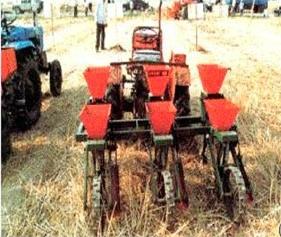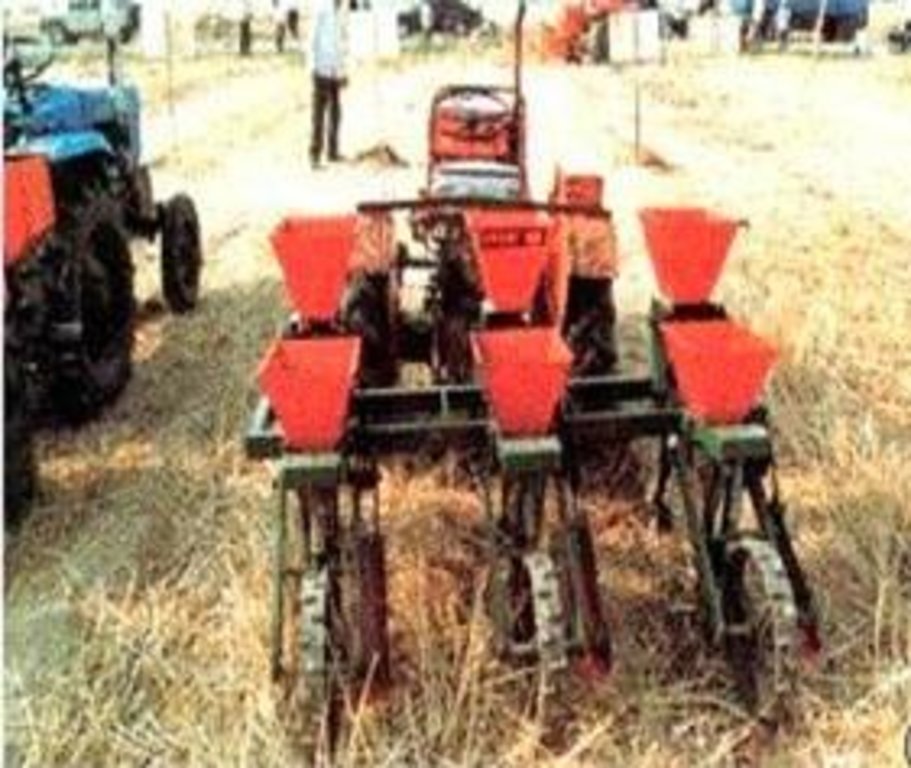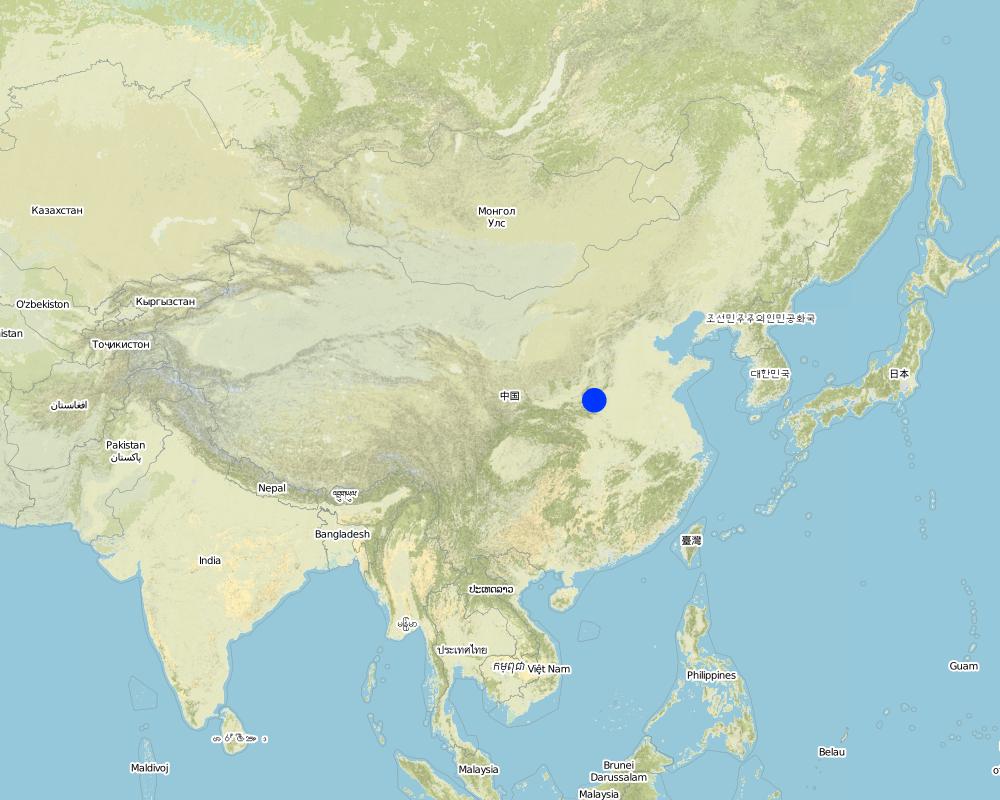Zero Tillage [Chine]
- Création :
- Mise à jour :
- Compilateur : Carin Pretorius
- Rédacteur : –
- Examinateur : David Streiff
No Tillage
technologies_969 - Chine
Voir les sections
Développer tout Réduire tout1. Informations générales
1.2 Coordonnées des personnes-ressources et des institutions impliquées dans l'évaluation et la documentation de la Technologie
Nom du ou des institutions qui ont facilité la documentation/ l'évaluation de la Technologie (si pertinent)
ISRIC World Soil Information (ISRIC World Soil Information) - Pays-Bas1.3 Conditions relatives à l'utilisation par WOCAT des données documentées
Quand les données ont-elles été compilées (sur le terrain)?
17/05/2002
Le compilateur et la(les) personne(s) ressource(s) acceptent les conditions relatives à l'utilisation par WOCAT des données documentées:
Oui
2. Description de la Technologie de GDT
2.1 Courte description de la Technologie
Définition de la Technologie:
Zero tillage technology was developed to protect the soils from sealing rainfall, to achieve and maintain a open internal soil structure, to enhance biological processes in the soil, and to develop a means for safe disposal of any surface runoff that nevertheless will occur.
2.2 Description détaillée de la Technologie
Description:
No tillage with residual mulching is developed to minimally disturb soil structure, directly to sow in the residual mulching covered soils. The crop system is rotated. It is used to maintain the soil moisture and particles that would be moved by runoff and improve soil fertility.
2.3 Photos de la Technologie
2.5 Pays/ région/ lieux où la Technologie a été appliquée et qui sont couverts par cette évaluation
Pays:
Chine
Région/ Etat/ Province:
Henan province
Map
×2.6 Date de mise en œuvre de la Technologie
Si l'année précise est inconnue, indiquez la date approximative: :
- il y a moins de 10 ans (récemment)
2.7 Introduction de la Technologie
Spécifiez comment la Technologie a été introduite: :
- par le biais de projets/ d'interventions extérieures
Commentaires (type de projet, etc.) :
USA, Canada
3. Classification de la Technologie de GDT
3.2 Type(s) actuel(s) d'utilisation des terres, là où la Technologie est appliquée

Terres cultivées
- Cultures annuelles
Commentaires:
Major land use problems (compiler’s opinion): Traditional till farming (multi-till system) has made soil loose and easily being moved on the dry and semi-dry slope farmland. No coverage exist after harvest and till leading to serious erosion. Meanwhile less and less organic fertilizer is applied and replaced by increase in chemical fertilizer use so that soil fertility and crop quality decline.
Major land use problems (land users’ perception): More and more input are needed to maintain stable yield, quality of the crops and fruits are declining.
Type of cropping system and major crops comments: After harvest of wheat in June, corn or peanut or bean are saw and harvest in later autumn
3.3 Informations complémentaires sur l'utilisation des terres
Approvisionnement en eau des terres sur lesquelles est appliquée la Technologie:
- pluvial
Commentaires:
Water supply: rainfed, mixed rainfed - irrigated
Nombre de période de croissance par an: :
- 1
Précisez:
Longest growing period in days: 180Longest growing period from month to month: Apr - SepSecond longest growing period in days: 90Second longest growing period from month to month: Jun - Sep
3.4 Groupe de GDT auquel appartient la Technologie
- perturbation minimale du sol
3.5 Diffusion de la Technologie
Spécifiez la diffusion de la Technologie:
- répartie uniformément sur une zone
Si la Technologie est uniformément répartie sur une zone, indiquez la superficie couverte approximative:
- 100-1 000 km2
Commentaires:
Total area covered by the SLM Technology is 800 m2.
This technique has been successfully applied in the slope farmland, especially in the Loess Plateau and in the dry-semidry regions in the NW China. It is an ideal approach to infiltrate all precipitation in soils and reduce soil erosion and water loss in slope farmland.
3.6 Mesures de GDT constituant la Technologie

pratiques agronomiques
- A3: Traitement de la couche superficielle du sol
Commentaires:
Main measures: agronomic measures
Type of agronomic measures: mulching, zero tillage / no-till
3.7 Principaux types de dégradation des terres traités par la Technologie

érosion hydrique des sols
- Wt: perte de la couche superficielle des sols (couche arable)/ érosion de surface
- Wg: ravinement/ érosion en ravines

érosion éolienne des sols
- Et: perte de la couche superficielle des sols (couche arable)

dégradation chimique des sols
- Cn: baisse de la fertilité des sols et réduction du niveau de matière organique (non causée par l’érosion)

dégradation hydrique
- Ha: aridification
Commentaires:
Main type of degradation addressed: Wt: loss of topsoil / surface erosion, Wg: gully erosion / gullying, Ha: aridification
Secondary types of degradation addressed: Et: loss of topsoil, Cn: fertility decline and reduced organic matter content
Main causes of degradation: other human induced causes (specify) (agricultural causes - irrational tillage on the slopeland), land tenure (Land subdivision)
Secondary causes of degradation: other natural causes (avalanches, volcanic eruptions, mud flows, highly susceptible natural resources, extreme topography, etc.) specify (insufficient rainfall and not well distribution), Lack of enforcement of legislat./authority
3.8 Prévention, réduction de la dégradation ou réhabilitation des terres dégradées
Spécifiez l'objectif de la Technologie au regard de la dégradation des terres:
- prévenir la dégradation des terres
4. Spécifications techniques, activités, intrants et coûts de mise en œuvre
4.2 Spécification/ explications techniques du dessin technique
Technical knowledge required for field staff / advisors: moderate
Technical knowledge required for land users: moderate
Main technical functions: control of dispersed runoff: retain / trap, control of dispersed runoff: impede / retard, improvement of ground cover, increase in organic matter, increase of infiltration, water harvesting / increase water supply, water spreading, sediment retention / trapping, sediment harvesting, reduction in wind speed, improvement of soil structure, increase in soil fertility
Secondary technical functions: increase / maintain water stored in soil
Mulching
Material/ species: film
Quantity/ density: 60% of sur
Remarks: alignment
Agronomic measure: residual cover
Material/ species: residual, straw
Quantity/ density: 80% of sur
Remarks: mean
Zero tillage / no-till
Remarks: Leaving residual after havest
4.3 Informations générales sur le calcul des intrants et des coûts
Indiquez la monnaie utilisée pour le calcul des coûts:
- dollars US
Indiquez le coût salarial moyen de la main d'œuvre par jour:
5.00
4.5 Coûts et intrants nécessaires à la mise en place
Commentaires:
Duration of establishment phase: 96 month(s)
4.6 Activités d'entretien/ récurrentes
| Activité | Type de mesures | Calendrier/ fréquence | |
|---|---|---|---|
| 1. | applying fertilizer | Agronomique | after harvest / each cropping season |
| 2. | Sowing using no-till machine | Agronomique | after harvest / each cropping season |
| 3. | weeding | Agronomique | crop growing / each cropping season |
4.7 Coûts et intrants nécessaires aux activités d'entretien/ récurrentes (par an)
Commentaires:
Machinery/ tools: No-till machine, tractor
Subsidy is needed at the beginning of the SWC implementation.
4.8 Facteurs les plus importants affectant les coûts
Décrivez les facteurs les plus importants affectant les coûts :
Zero tillage machine and tractor
5. Environnement naturel et humain
5.1 Climat
Précipitations annuelles
- < 250 mm
- 251-500 mm
- 501-750 mm
- 751-1000 mm
- 1001-1500 mm
- 1501-2000 mm
- 2001-3000 mm
- 3001-4000 mm
- > 4000 mm
Spécifications/ commentaires sur les précipitations:
646mm for Luoyang/Henan
Zone agro-climatique
- semi-aride
- aride
5.2 Topographie
Pentes moyennes:
- plat (0-2 %)
- faible (3-5%)
- modéré (6-10%)
- onduleux (11-15%)
- vallonné (16-30%)
- raide (31-60%)
- très raide (>60%)
Reliefs:
- plateaux/ plaines
- crêtes
- flancs/ pentes de montagne
- flancs/ pentes de colline
- piémonts/ glacis (bas de pente)
- fonds de vallée/bas-fonds
Zones altitudinales:
- 0-100 m
- 101-500 m
- 501-1000 m
- 1001-1500 m
- 1501-2000 m
- 2001-2500 m
- 2501-3000 m
- 3001-4000 m
- > 4000 m
Indiquez si la Technologie est spécifiquement appliquée dans des:
- non pertinent
Commentaires et précisions supplémentaires sur la topographie:
Hill slopes: SE part of the Loess Plateau, mainly hilly area
Plateau / plains: low proportion in the whole SWC applied area
Valley floors: small area in the whole SWC applied area but output high with better irrigation systems
Slopes moderate: There is not much terraces built in this area and slope degree remains natural status
Slopes hilly: This part of the slope land have been developed for cultivation due to increasing population
Slopes steep: It is used by mixed treatment of forest and crop land.
5.3 Sols
Profondeur moyenne du sol:
- très superficiel (0-20 cm)
- superficiel (21-50 cm)
- modérément profond (51-80 cm)
- profond (81-120 cm)
- très profond (>120 cm)
Texture du sol (de la couche arable):
- moyen (limoneux)
- fin/ lourd (argile)
Texture du sol (> 20 cm sous la surface):
- moyen (limoneux)
Matière organique de la couche arable:
- moyen (1-3%)
- faible (<1%)
Si disponible, joignez une description complète du sol ou précisez les informations disponibles, par ex., type de sol, pH/ acidité du sol, capacité d'échange cationique, azote, salinité, etc.
Soil depth deep: In the area the soil parant material is loess with thickness.
Soil depth shallow: Mainly distributes in the mountain slope
Soil texture medium: The soil parent material is loess which is loose with porous structure of particle "point-prism contact".
Soil texture fine heavy: The loess mainly originates from aeolian deposition.
Topsoil organic matter medium: organic matter is applied.
Topsoil organic matter low: mainly loess (earth) with little organic matter applied in the area
Soil fertility is low or very low and little or very little organic matter is applied in the area
Soil texture medium: The soil parent material is loess which is loose with porous structure of particle "point-prism contact".
Soil texture fine: The loess mainly originates from aeolian deposition.
Soil drainage is medium because the soil (earth) is loose.
Soil water storage is low or medium: No mulching on the soil surface and high evaporation and low under gound level.
5.6 Caractéristiques des exploitants des terres appliquant la Technologie
Revenus hors exploitation:
- 10-50% de tous les revenus
Niveau relatif de richesse:
- moyen
- riche
Niveau de mécanisation:
- traction animale
- mécanisé/ motorisé
Indiquez toute autre caractéristique pertinente des exploitants des terres:
Population density: 100-200 persons/km2
Annual population growth: 0.5% - 1%
20% of the land users are rich and own 20% of the land (generally young person with skills).
80% of the land users are average wealthy and own 80% of the land.
Off-farm income specification: SWC users can get much more subsidies from governments or projects than those who take no SWC technology.
Animal traction is individual
Machines are shared or leased.
5.8 Propriété foncière, droits d’utilisation des terres et de l'eau
Propriété foncière:
- état
- individu, avec titre de propriété
Droits d’utilisation des terres:
- loué
- individuel
6. Impacts et conclusions
6.1 Impacts sur site que la Technologie a montrés
Impacts écologiques
Cycle de l'eau/ ruissellement
ruissellement de surface
Quantité avant la GDT:
30
Quantité après la GDT:
5
Sols
perte en sol
Quantité avant la GDT:
25
Quantité après la GDT:
3
6.4 Analyse coûts-bénéfices
Quels sont les bénéfices comparativement aux coûts de mise en place (du point de vue des exploitants des terres)?
Rentabilité à court terme:
positive
Rentabilité à long terme:
très positive
Quels sont les bénéfices comparativement aux coûts d'entretien récurrents (du point de vue des exploitants des terres)?
Rentabilité à court terme:
légèrement positive
Rentabilité à long terme:
très positive
6.5 Adoption de la Technologie
- 10-50%
Si disponible, quantifiez (nombre de ménages et/ou superficie couverte):
800 families (35 percent)
Parmi tous ceux qui ont adopté la Technologie, combien d'entre eux l'ont fait spontanément, à savoir sans recevoir aucune incitation matérielle ou aucun paiement?
- 10-50%
Commentaires:
30% of land user families have adopted the Technology with external material support
600 land user families have adopted the Technology with external material support
Comments on acceptance with external material support: estimates
5% of land user families have adopted the Technology without any external material support
200 land user families have adopted the Technology without any external material support
Comments on spontaneous adoption: estimates
There is a strong trend towards spontaneous adoption of the Technology
Comments on adoption trend: The technique can bring ecological, social and economic benefits
7. Références et liens
7.2 Références des publications disponibles
Titre, auteur, année, ISBN:
Report of ninth-Five plan project on Dryland Farming. Jan. 2002.
Disponible à partir d'où? Coût?
internal reference
Titre, auteur, année, ISBN:
Introduction of Luoayng physicography. 2000.
Disponible à partir d'où? Coût?
unpublished materials
Titre, auteur, année, ISBN:
No-till farming for sustainable rural development. 2002.
Disponible à partir d'où? Coût?
World Bank
Titre, auteur, année, ISBN:
A road map from conventional to no-till farming. 2002.
Disponible à partir d'où? Coût?
World Bank
Titre, auteur, année, ISBN:
Conservation agriculture. 2001.
Disponible à partir d'où? Coût?
FAO
Liens et modules
Développer tout Réduire toutLiens
Aucun lien
Modules
Aucun module trouvé




